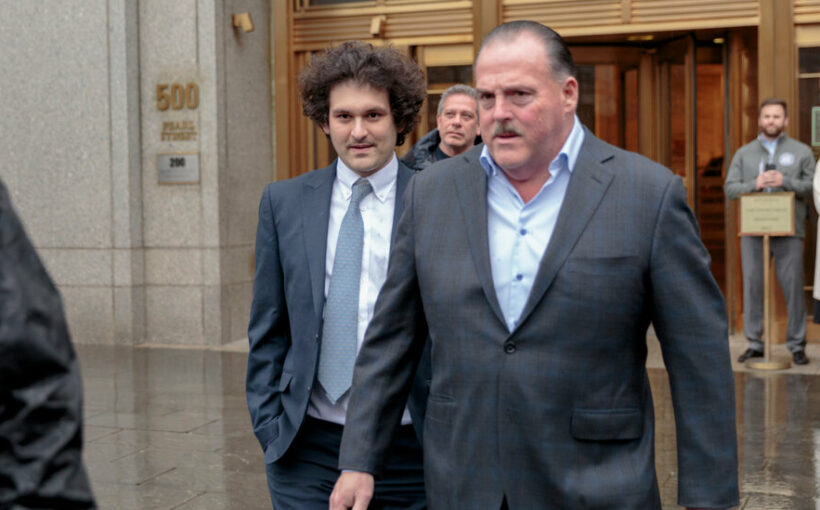Federal prosecutors on Thursday added new details to a charge filed in December about Sam Bankman-Fried’s campaign donations, accusing him and two uncharged former executives of FTX, the collapsed cryptocurrency exchange, of using tens of millions of dollars in customer money to illegally donate to federal political campaigns.
In a revised indictment, prosecutors said that Mr. Bankman-Fried, the FTX founder, and two former employees used straw donors — a person who makes a contribution in someone else’s name to avoid limits on individuals or companies — in their bid to influence politicians in Washington.
Federal election law bars a person from donating money to a political campaign by disguising or concealing the source of that money.
The indictment added four new charges against Mr. Bankman-Fried, adding to the eight charges in the original charging document. The updated document also provides fresh details about the ways in which Mr. Bankman-Fried sought to defraud customers and investors.
Mr. Bankman-Fried pleaded not guilty to the prior charges. A spokesman for Mr. Bankman-Fried, 30, was not immediately available for comment.
What to Know About the Collapse of FTX
What is FTX? FTX is a now bankrupt company that was one of the world’s largest cryptocurrency exchanges. It enabled customers to trade digital currencies for other digital currencies or traditional money; it also had a native cryptocurrency known as FTT. The company, based in the Bahamas, built its business on risky trading options that are not legal in the United States.
Who is Sam Bankman-Fried? He is the 30-year-old founder of FTX and the former chief executive of FTX. Once a golden boy of the crypto industry, he was a major donor to the Democratic Party and known for his commitment to effective altruism, a charitable movement that urges adherents to give away their wealth in efficient and logical ways.
How did FTX’s troubles begin? Last year, Changpeng Zhao, the chief executive of Binance, the world’s largest crypto exchange, sold the stake he held in FTX back to Mr. Bankman-Fried, receiving a number of FTT tokens in exchange. In November, Mr. Zhao said he would sell the tokens and expressed concerns about FTX’s financial stability. The move, which drove down the price of FTT, spooked investors.
What led to FTX's collapse? Mr. Zhao’s announcement drove down the price and spooked investors. Traders rushed to withdraw from FTX, causing the company to have a $8 billion shortfall. Binance, FTX’s main rival, offered a loan to save the company but later pulled out, forcing FTX to file for bankruptcy on Nov. 11.
Why was Mr. Bankman-Fried arrested? FTX’s collapse kicked off investigations by the Justice Department and the Securities and Exchange Commission focused on whether FTX improperly used customer funds to prop up Alameda Research, a crypto trading platform that Mr. Bankman-Fried had helped start. On Dec. 12, Mr. Bankman-Fried was arrested in the Bahamas for lying to investors and committing fraud. The day after, the S.E.C. also filed civil securities fraud charges.
Among the new or modified charges: conspiracy to commit bank fraud, conspiracy to operate an unlicensed money transmitting business and conspiracy to defraud the Federal Election Commission.
The indictment, filed in Federal District Court in Manhattan, charged that Mr. Bankman-Fried and two unnamed FTX executives made over 300 political contributions that were “unlawful because they were made in the name of a straw donor or paid with corporate funds.”
The initial indictment had provided scant details about the campaign finance charge against Mr. Bankman-Fried and even avoided using the term “straw donor.”
Prosecutors said in the new indictment that funds for the donations in question included money that FTX customers had deposited in their trading accounts at the cryptocurrency exchange. The money was transferred from bank accounts maintained by Alameda Research, the crypto trading firm that Mr. Bankman-Fried had founded two years before he launched FTX in 2019, the indictment said.
The indictment refers to the two former FTX executives involved in the campaign finance scheme as co-conspirators and details their efforts to conceal their activities but did not identify them by name.
The Aftermath of FTX’s Downfall
The spectacular collapse of the crypto exchange in November has left the industry stunned.
Bankruptcy lawyers for FTX have said that about $90 million in customer money was used to make campaign contributions, and that the lawyers have sent letters to all the recipients of that campaign cash asking for it to be returned.
The revised indictment said that one of the former FTX executives, identified as co-conspirator 1, was uncomfortable with making a $1 million donation in his name to a so-called super political action committee that was affiliated with pro-LGBTQ causes. Yet the former executive was urged to donate by an unnamed political consultant working for Mr. Bankman-Fried.
The consultant is quoted in the indictment as telling the former FTX executive that he would be “giving to a lot of woke” causes “for transactional purposes,” using a profanity.
Two of Mr. Bankman-Fried’s former top executives at FTX, Caroline Ellison and Gary Wang, have already pleaded guilty and are cooperating with the investigation.
The new charges come less than a week after a federal judge who is overseeing Mr. Bankman-Fried’s multibillion-dollar fraud case indicated that he was prepared to revoke his bail for his repeated testing of the boundaries set when Mr. Bankman-Fried was allowed to remain free but confined to the Palo Alto home of his parents with an ankle monitor, as part of a $250 million bond package.
Prosecutors twice in recent weeks had asked the judge, Lewis A. Kaplan of Federal District Court in Manhattan, to curtail Mr. Bankman-Fried’s activities, asking that he be barred from using encrypted apps and to limit his ability to communicate with current and former FTX employees.
Kenneth Vogel contributed reporting.
Source: Read Full Article
